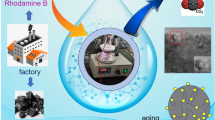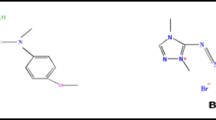Abstract
The widespread adoption of electrified carbon nanotube membranes (ECM) requires to better understand process effectiveness according to limiting phenomena of natural organic matters (NOMs). In this study, the influences of various NOM fractions were investigated on the oxidative degradation of Rhodamine B (RhB) in ECM. The results showed the decolorizing efficiencies of RhB in the presence of humic acid (HA) were still above 96%, while bovine serum albumin (BSA) reduced firstly and then increased the decolorizing efficiencies of RhB. The decolorizing efficiencies of RhB with alginate (AA) were over 98% at the first 15 min but decreased gradually to 76% after 150 min. These different performances of HA, BSA and AA were mainly due to their influences on the electrochemical reactivity characterization of ECM. ECM with the BSA depositing layer showed the highest exchange current density (j0), while the AA depositing layer restrained electron-transfer activity of ECM. Cyclic voltammetry (CV) experiments showed that the partial electrooxidation of BSA would occur in ECM with its degradation product observed in the effluent. The variation of electrochemical reactivity characterization of ECM resulted into its electri-oxidation and electri-adsorption rates to be the largest with BSA, followed by AA and HA.







Similar content being viewed by others
Data availability
All data generated or analyzed during this study are included in this published article and its supplementary information files.
Code availability
Not applicable
References
Abdel-Shafy HI, Mansour MSM (2016) A review on polycyclic aromatic hydrocarbons: source, environmental impact, effect on human health and remediation. Egypt J Pet 25(1):107–123. https://doi.org/10.1016/j.ejpe.2015.03.011
Bradley PM, Journey CA, Romanok KM, Breitmeyer SE, Button DT, Carlisle DM, Huffman BJ, Mahler BJ, Nowell LH, Qi SL, Smalling KL, Waite IR, Van Meter PC (2021) Multi-region assessment of chemical mixture exposures and predicted cumulative effects in USA wadeable urban/agriculture-gradient streams. Sci Total Environ 773:145062. https://doi.org/10.1016/j.scitotenv.2021.145062
Cao ZP, Li SS, Zhang JL, Zhang HW (2016) An electro-microbial membrane system with anti-fouling function for phenol wastewater treatment. J Chem Technol Biotechnol 92(3):693–699. https://doi.org/10.1002/jctb.5056
Chakraborty M, Bera KK, Chatterjee S, Ghosh A, Bhattacharya SK (2021) Synthesis of mesoporous BiOI flower and facile in-situ preparation of BiOI/BiOCl mixture for enhanced photocatalytic degradation of toxic dye, Rhodamine-B. J Photochemi Photobiol 8:100077. https://doi.org/10.1016/j.jpap.2021.100077
Chen KL, Mylon SE, Elimelech M (2006) Aggregation kinetics of alginate-coated hematite nanoparticles in monovalent and divalent electrolytes. Environ Sci Technol 40(5):1516–1523. https://doi.org/10.1021/es0518068
Dorčák V, Ostatná V, Paleček E (2013) Electrochemical reduction and oxidation signals of angiotensin peptides. Role of individual amino acid residues. Electrochem Commun 31:80–83. https://doi.org/10.1016/j.elecom.2013.03.016
Drewes JE, Fox P (1999) Fate of natural organic matter (nom) during groundwater recharge using reclaimed water. Water Sci Technol 40(9):241–248. https://doi.org/10.1016/S0273-1223(99)00662-9
Duan W, Ronen A, de Leon JV, Dudchenko A, Yao S, Corbala-Delgado J, Yan A, Matsumoto M, Jassby D (2016) Treating anaerobic sequencing batch reactor effluent with electrically conducting ultrafiltration and nanofiltration membranes for fouling control. J Membr Sci 504:104–112. https://doi.org/10.1016/j.memsci.2016.01.011
Enache TA, Oliveira-Brett AM (2013) Peptide methionine sulfoxide reductase A (MsrA): direct electrochemical oxidation on carbon electrodes. Bioelectrochemistry 89:11–18. https://doi.org/10.1016/j.bioelechem.2012.08.004
Fan X, Zhao H, Liu Y, Quan X, Yu H, Chen S (2015) Enhanced permeability, selectivity, and antifouling ability of CNTs/Al2O3 membrane under electrochemical assistance. Environ Sci Technol 49(4):2293–2300. https://doi.org/10.1021/es5039479
Gao J, Vecitis CD (2013) Electrocatalysis aqueous phenol with carbon nanotubes networks as anodes: electrodes passivation and regeneration and prevention. Electrochim Acta 98:131–138. https://doi.org/10.1016/j.electacta.2013.02.127
Gayen P, Spataro J, Avasarala S, Ali AM, Cerrato JM, Chaplin BP (2018) Electrocatalytic reduction of nitrate using Magnéli phase TiO2 reactive electrochemical membranes doped with Pd-based catalysts. Environ Sci Technol 52(16):9370–9379. https://doi.org/10.1021/acs.est.8b03038
Geissen V, Mol H, Klumpp E, Umlauf G, Nadal M, van der Ploeg M, van de Zee SEATM, Ritsema CJ (2015) Emerging pollutants in the environment: a challenge for water resource management. Int Soil Water Conserv Res 3(1):57–65. https://doi.org/10.1016/j.iswcr.2015.03.002
Gogos A, Voegelin A, Kaegi R (2018) Influence of organic compounds on the sulfidation of copper oxide nanoparticles. Environ Sci Nano 5(11):2560–2569. https://doi.org/10.1039/c8en00523k
Guéguen C, Cuss CW (2011) Characterization of aquatic dissolved organic matter by asymmetrical flow field-flow fractionation coupled to UV–Visible diode array and excitation emission matrix fluorescence. J Chromatogr A 1218(27):4188–4198. https://doi.org/10.1016/j.chroma.2010.12.038
Han Q, Yan H, Zhang F, Xue N, Wang Y, Chu Y, Gao B (2015) Trihalomethanes (THMs) precursor fractions removal by coagulation and adsorption for bio-treated municipal wastewater: molecular weight, hydrophobicity/hydrophily and fluorescence. J Hazard Mater 297:119–126. https://doi.org/10.1016/j.jhazmat.2015.04.070
Ihsanullah (2019) Carbon nanotube membranes for water purification: Developments, challenges, and prospects for the future. Sep Purif Technol 209:307–337. https://doi.org/10.1016/j.seppur.2018.07.043
Jin L, You S, Duan X, Yao Y, Yang J, Liu Y (2022) Peroxymonosulfate activation by Fe3O4-MnO2/CNT nanohybrid electroactive filter towards ultrafast micropollutants decontamination: performance and mechanism. J Hazard Mater 423:127111. https://doi.org/10.1016/j.jhazmat.2021.127111
Karki AJ, Cappelli P, Dirks C, Pekar H, Hellenäs KE, Rosén J, Westerberg E (2020) New efficient methodology for screening of selected organic micropollutants in raw- and drinking water from 90 Swedish water treatment plants. Sci Total Environ 724:138069. https://doi.org/10.1016/j.scitotenv.2020.138069
Liao AA, Spitzer M, Motheo AJ, Bertazzoli R (2008) Electrocombustion of humic acid and removal of algae from aqueous solutions. J Appl Electrochem 38:721–727. https://doi.org/10.1007/s10800-008-9502-x
Liu H, Liu J, Liu Y, Bertoldi K, Vecitis CD (2014) Quantitative 2D electrooxidative carbon nanotube filter model: insight into reactive sites. Carbon 80:651–664. https://doi.org/10.1016/j.carbon.2014.09.009
Liu Y, Wu P, Liu F, Li F, An X, Liu J, Wang Z, Shen C, Sand W (2019a) Electroactive modified carbon nanotube filter for simultaneous detoxification and sequestration of Sb (III). Environ Sci Technol 53(3):1527–1535. https://doi.org/10.1021/acs.est.8b05936
Liu X, Novak JT, He Z (2019b) Removal of landfill leachate ultraviolet quenching substances by electricity induced humic acid precipitation and electrooxidation in a membrane electrochemical reactor. Sci Total Environ 689:571–579. https://doi.org/10.1016/j.scitotenv.2019.06.329
Liu Y, Yang S, Jiang H, Yang B, Fang X, Shen C, Yang J, Sand W, Li F (2021) Sea Urchin-like FeOOH Functionalized electrochemical CNT filter for one-step arsenite decontamination. J Hazard Mater 407:124384. https://doi.org/10.1016/j.jhazmat.2020.124384
Mantel T, Jacki E, Ernst M (2021) Electrosorptive removal of organic water constituents by positively charged electrically conductive UF membranes. Water Res 201:117318. https://doi.org/10.1016/j.watres.2021.117318
Martínez-Huitle CA, Rodrigo MA, Sirés I, Scialdone O (2015) Single and coupled electrochemical processes and reactors for the abatement of organic water pollutants: a critical review. Chem Rev 115(24):13362–13407. https://doi.org/10.1021/acs.chemrev.5b00361
Mostafazadeh AK, De La Torre MS, Padilla Y, Drogui P, Brar SK, Tyagi RD, Bihan YL, Buelna G, Moroyoqui PG (2021) An insight into an electro-catalytic reactor concept for high value-added production from crude glycerol: optimization, electrode passivation, product distribution, and reaction pathway identification. Renew Energy 172:130–144. https://doi.org/10.1016/j.renene.2021.03.032
Panizza M, Cerisola G (2009) Direct and mediated anodic oxidation of organic pollutants. Chem Rev 109(12):6541–6569. https://doi.org/10.1021/cr9001319
Panizza M, Michaud PA, Cerisola G, Comninellis C (2001) Electrochemical treatment of wastewaters containing organic pollutants on boron-doped diamond electrodes: prediction of specific energy consumption and required electrode area. Electrochem Commun 3(7):336–339. https://doi.org/10.1016/S1388-2481(01)00166-7
Panizza M, Kapalka A, Comninellis C (2008) Oxidation of organic pollutants on BDD anodes using modulated current electrolysis. Electrochim Acta 53(5):2289–2295. https://doi.org/10.1016/j.electacta.2007.09.044
Qian B, Zhao Y, Fan M, Zhou W, Feng S, Wang Y, Li Y, Gao B (2021) The role of natural organic matter in the silver release from sludge generated from coagulation of wastewater spiked with silver nanoparticles. NanoImpact 23:100347. https://doi.org/10.1016/j.impact.2021.100347
Ren X, Pan L, Wang L (2015) Toxic effects upon exposure to benzo[a]pyrene in juvenile white shrimp Litopenaeus vannamei. Environ Toxicol Pharmacol 39(1):194–207. https://doi.org/10.1016/j.etap.2014.08.006
Shon HK, Vigneswaran S, Snyder SA (2006) Effluent organic matter (EfOM) in wastewater: constituents, effects, and treatment. Crit Rev Environ Sci Technol 36(4):327–374. https://doi.org/10.1080/10643380600580011
Sirés I, Brillas E, Oturan MA, Rodrigo MA, Panizza M (2014) Electrochemical advanced oxidation processes: today and tomorrow. A review. Environ Sci Pollut Res 21:8336–8367. https://doi.org/10.1007/s11356-014-2783-1
Su D, Ben W, Strobel BW, Qiang Z (2021) Impacts of wastewater treatment plant upgrades on the distribution and risks of pharmaceuticals in receiving rivers. J Hazard Mater 406:124331. https://doi.org/10.1016/j.jhazmat.2020.124331
Sun M, Wang X, Winter LR, Zhao Y, Ma W, Hedtke T, Kim JH, Elimelech M (2021) Electrified membranes for water treatment applications. ACS EST Eng 1(4):725–752. https://doi.org/10.1021/acsestengg.1c00015
Suprun EV, Khmeleva SA, Radko SP, Kozin SA, Archakov AI, Shumyantseva VV (2016) Direct electrochemical oxidation of amyloid-β peptides via tyrosine, histidine, and methionine residues. Electrochem Commun 65:53–56. https://doi.org/10.1016/j.elecom.2016.02.004
Tao P, Xu Y, Song C, Yin Y, Yang Z, Wen S, Wang S, Liu H, Li S, Li C, Wang T, Shao M (2017) A novel strategy for the removal of rhodamine B (RhB) dye from wastewater by coal-based carbon membranes coupled with the electric field. Sep Purif Technol 179:175–183. https://doi.org/10.1016/j.seppur.2017.02.014
Verlicchi P, Al Aukidy M, Zambello E (2012) Occurrence of pharmaceutical compounds in urban wastewater: removal, mass load and environmental risk after a secondary treatment—a review. Sci Total Environ 429:123–155. https://doi.org/10.1016/j.scitotenv.2012.04.028
Wang WL, Zhang X, Wu QY, Du Y, Hu HY (2017) Degradation of natural organic matter by UV/chlorine oxidation: molecular decomposition, formation of oxidation byproducts and cytotoxicity. Water Res 124:251–258. https://doi.org/10.1016/j.watres.2017.07.029
Wang Q, Wang B, Ma Y, Xing S (2018) Enhanced superoxide radical production for ofloxacin removal via persulfate activation with Cu-Fe oxide. Chem Eng J 354:473–480. https://doi.org/10.1016/j.cej.2018.08.055
Wu J, Zhu K, Xu H, Yan W (2019) Electrochemical oxidation of rhodamine B by PbO2/Sb-SnO2/TiO2 nanotube arrays electrode. Chin J Catal 40(6):917–927. https://doi.org/10.1016/S1872-2067(19)63342-5
Yang Y, Ok YS, Kim KH, Kwon EE, Tsang YF (2017) Occurrences and removal of pharmaceuticals and personal care products (PPCPs) in drinking water and water/sewage treatment plants: a review. Sci Total Environ 596-597:303–320. https://doi.org/10.1016/j.scitotenv.2017.04.102
Yang S, Liu Y, Shen C, Li F, Yang B, Huang M, Yang M, Wang Z, Sand W (2020) Rapid decontamination of tetracycline hydrolysis product using electrochemical CNT filter: mechanism, impacting factors and pathways. Chemosphere 244:125525. https://doi.org/10.1016/j.chemosphere.2019.125525
Yin H, Guo Q, Lei C, Chen W, Huang B (2020) Electrochemical-driven carbocatalysis as highly efficient advanced oxidation processes for simultaneous removal of humic acid and Cr (VI). Chem Eng J 396:125156. https://doi.org/10.1016/j.cej.2020.125156
Yonemoto Y, Tanaka H, Yamashita T, Kitabatake N, Ishida Y, Kimura A, Murata K (1993) Promotion of germination and shoot elongation of some plants by alginate oligomers prepared with bacterial alginate lyase. J Ferment Bioeng 75(1):68–70. https://doi.org/10.1016/0922-338X(93)90181-7
Zhao L, Zhang X, Liu Z, Deng C, Xu H, Wang Y, Zhu M (2021) Carbon nanotube-based electrocatalytic filtration membrane for continuous degradation of flow-through Bisphenol A. Sep Purif Technol 265:118503. https://doi.org/10.1016/j.seppur.2021.118503
Funding
This study was financially supported by Shandong Provincial Natural Science Foundation (No. ZR2019MEE006).
Author information
Authors and Affiliations
Contributions
In this work, YW proposed research contents and directed the research project. Most of experiments were performed by YC and YL. Degradation product analysis was performed by XN. Radical trapping tests were carried out by QM. The morphology tests was performed by MW. The paper was written by YW, JD, YC and YL. All the authors analyzed the results and reviewed the paper.
Corresponding author
Ethics declarations
Ethics approval and consent to participate
Not applicable
Consent for publication
Not applicable
Competing interests
The authors declare no competing interests.
Additional information
Responsible Editor: Angeles Blanco
Publisher’s note
Springer Nature remains neutral with regard to jurisdictional claims in published maps and institutional affiliations.
Supplementary Information
ESM 1
(DOCX 450 kb)
Rights and permissions
About this article
Cite this article
Chu, Y., Li, Y., Ni, X. et al. Effect of the presence of various natural organic matters on anodic oxidation of electrified carbon nanotube membrane. Environ Sci Pollut Res 29, 71179–71189 (2022). https://doi.org/10.1007/s11356-022-20716-x
Received:
Accepted:
Published:
Issue Date:
DOI: https://doi.org/10.1007/s11356-022-20716-x




